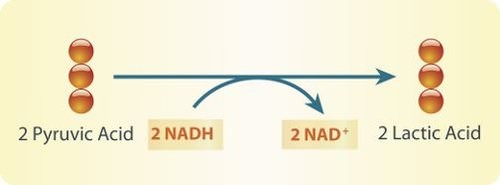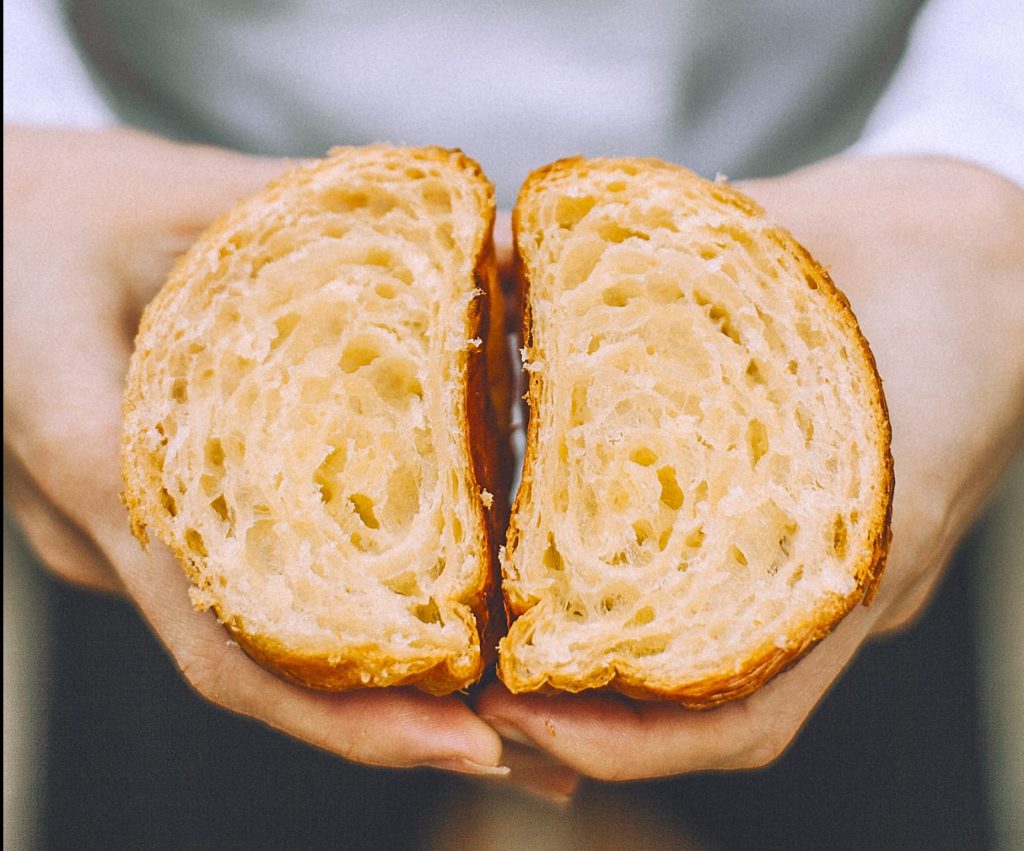6.3 Fermentation
Anaerobic respiration enables organisms to convert energy for their use without oxygen. With oxygen, organisms can use aerobic cellular respiration to produce up to 38 molecules of ATP from just one glucose molecule. Without oxygen, organisms only produce two molecules of ATP per glucose molecule. Anaerobic respiration starts with glycolysis, the first stage of cellular respiration. Glycolysis does not require oxygen but produces two molecules of ATP for each glucose molecule. For glycolysis to work, NAD+ must accept electrons. For glycolysis to continue, NADH must be converted back to NAD+ for reuse. Since no oxygen is present, the ETC is not functioning, so the NADH needs to drop its electrons elsewhere. Different organisms do this step in different ways. Fermentation is a type of anaerobic respiration that regenerates NAD+ by adding the electrons from NADH to an organic molecule. There are two main types of fermentation:
Lactic Acid Fermentation
Animals and certain bacteria, including those in yogurt, use lactic acid fermentation. During intense exercise, your muscle cells rely on this process for short periods when your muscles use ATP faster than your cardiovascular system can deliver oxygen. In this process, NADH transfers electrons back onto pyruvate (pyruvic acid), which converts it into lactic acid. The NAD+ cycles back to allow glycolysis to continue, so more ATP is made.

Alcohol Fermentation
Alcohol fermentation produces ethanol, an alcohol. It is carried out by single-celled fungi (called yeasts) and some bacteria. Pyruvate is broken down to release a carbon dioxide molecule, resulting in a 2-carbon molecule (acetaldehyde) remaining. NADH drops its electrons onto the acetaldehyde, which converts it into ethanol. The resulting NAD+ is reused in glycolysis to continue making ATP. We use alcoholic fermentation to make bread, wine, beer, and even biofuels.


|
Feature |
Aerobic Respiration |
Anaerobic Respiration |
|---|---|---|
| Requires oxygen? | Yes | No |
| Glucose breakdown | Complete | Incomplete |
| End products | CO₂ and H₂O | Animal cells: lactic acid Plant cells and yeast: carbon dioxide and ethanol |
| ATP produced | About 38 | 2 |
Exercises 6.3.1
Text Description
- To generate about 32 ATP in the presence of oxygen.
- To allow cells to survive without using ATP.
- To regenerate NAD+ so glycolysis can continue to happen.
- The citric acid cycle
- Oxidative phosphorylation
- Glycolysis
- addition
- wouldn’t
- later
- persisted
- primitive
- late
- universal
4. Aerobic or Anaerobic?
Draggable options: Requires oxygen, Lactic acid produced, Ethanol produced, Is less efficient, Incomplete breakdown of glucose, Makes more ATP per glucose, Does not require oxygen, Complete breakdown of glucose, 2 ATP produced, About 36 ATP produced, H2O and CO2 produced.
Answers:
4. Aerobic: Requires oxygen, About 36 ATP produced, Complete breakdown of glucose, H20 and C02 produced, Makes more ATP per glucose
Anaerobic: Does not require oxygen, Incomplete breakdown of glucose, Ethanol produced, Lactic acid produced, 2 ATP produced, Is less efficient.
Anaerobic Cellular Respiration in Prokaryotes
Ancient prokaryotes likely generated ATP exclusively from glycolysis before oxygen was abundant in Earth’s atmosphere. Since nearly all organisms complete glycolysis, it suggests that it evolved in primitive organisms and persisted, with the addition of other metabolic pathways that evolved later.
Some prokaryotes use different ways to convert NADH back into NAD+. The group of Archaea called methanogens reduces carbon dioxide to methane to oxidize NADH. These microorganisms are found in soil and the digestive tracts of ruminants, such as cows. Similarly, sulphate-reducing bacteria and Archaea, most of which are anaerobic, reduce sulphate to hydrogen sulphide to regenerate NAD+ from NADH.
“4.11 Anaerobic Processes” from Human Biology by Christine Miller is licensed under a Creative Commons Attribution-NonCommercial 4.0 International License, except where otherwise noted.
“4.4 Fermentation” from Biology and the Citizen by Colleen Jones is licensed under a Creative Commons Attribution 4.0 International License, except where otherwise noted.

